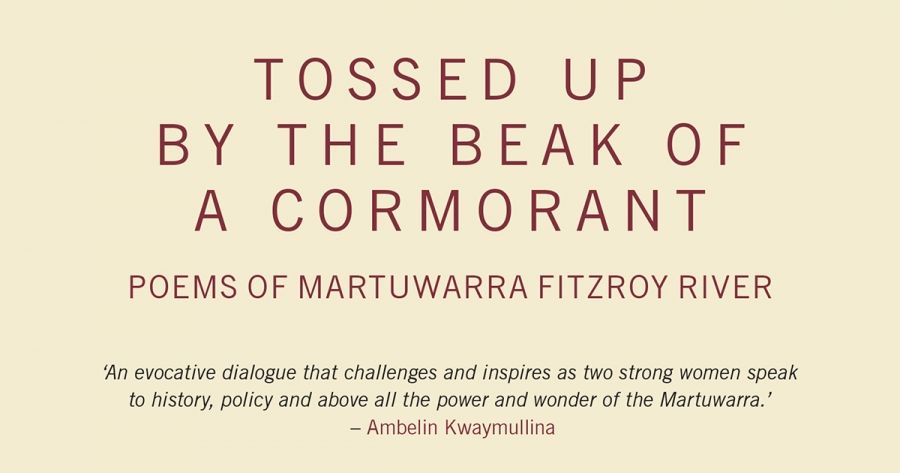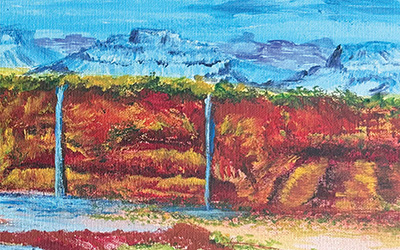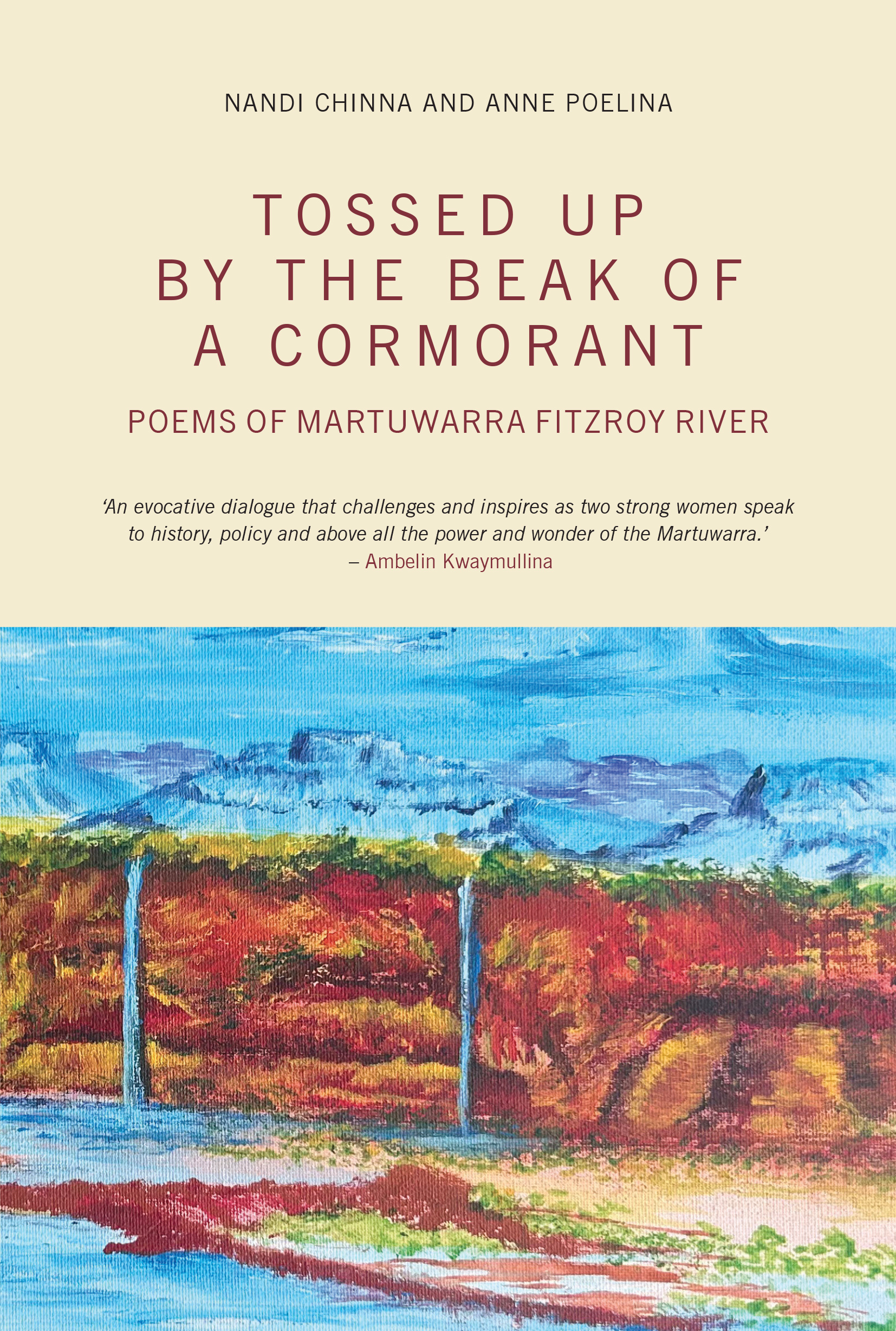
- Free Article: No
- Contents Category: Poetry
- Review Article: Yes
- Article Title: River’s flow
- Article Subtitle: A Martuwarra collaboration
- Online Only: No
- Custom Highlight Text:
In her fifth full-length poetry collection, Tossed up by the Beak of a Cormorant, Nandi Chinna continues to write about her engagement with the natural world. Authored in collaboration with Wagaba Nyikina Warrwa Elder, Anne Poelina, this book sees her move north and west into the Kimberley. This is where the Martuwarra (Fitzroy River) runs through Bunuba, Gooniyandi, Nyikina, Walmajarri, and Wangkatjungka Country. It is a place that poetry readers will recognise from the geographically proximate classic Reading the Country (1984) by Paddy Roe, Stephen Muecke, and Krim Bentarrak, Ngarla Songs (2003) by Alexander Brown and Brian Geytenbeek, and the ethnopoetic George Dyungayan’s Bulu Line (2014), edited by Stuart Cooke. With that in mind, Chinna’s Kimberley is a place that is remote for many readers, but not entirely unknown.
- Featured Image (400px * 250px):

- Alt Tag (Featured Image): Robert Wood reviews ‘Tossed up by the Beak of a Cormorant’ by Nandi Chinna and Anne Poelina
- Book 1 Title: Tossed up by the Beak of a Cormorant
- Book 1 Biblio: Fremantle Press, $29.99 pb, 112 pp
- Book 1 Cover Small (400 x 600):

- Book 1 Cover (800 x 1200):

Upon her arrival in the region, Chinna shares a twin sense of recognition and ignorance: ‘When I moved from the south-west of Western Australia up to Fitzroy Crossing in the remote north-west of the state, my first forays ... felt as bewildering as if I had been gagged and blindfolded. I felt as though I had left Australia, and with it lost all of my familiar languages and strategies as an artist and writer.’
For a time, the poet simply walks and reflects, sits still and observes, not quite knowing how to create poetry in a place new to her yet old with storytellers. After a community meeting with Elders where she hears about plans to frack near the Martuwarra, Chinna comes to the conclusion that she ‘somehow wanted to contribute to the campaign to protect [it]’. She reaches out to Poelina to forge a collaboration. Tossed up by the Beak of a Cormorant is one such result and complements other activist engagements.
In the book there are poems on kayaking (‘At Danggu’), resting (‘Introducing Martuwarra’), cycling (‘Reciprocal Gifts’), wandering (‘Impelled By Orpheus’), running (‘Waramba First Flood’), and simply living by, with, and in the river. Like Chinna’s previous collection, Swamp (2014), which chronicled the wetlands of the Swan Coastal Plain, it is the landscape that becomes the central character, even as the poets inhabit it. This is an activist eco-poetics of observation where self dissolves into the water’s flow and we realise how rich in natural abundance the region is. Although Chinna feels as if she had ‘left Australia’, there are contiguities with the south-west and Adelaide, where she formerly lived. Birds feature often (‘Australia Day Birds’), and there are poems about football (‘Unbearable Weight of the Road II’) and Christmas (‘12 Days Until Christmas’). These familiar national iconographies are remade aslant, often recognisable because of their remote community touchpoints like Troopies, tinned food, and tents. This remote iconography has also been shared most recently in Australian poetry by Phillip Hall, with Sweetened in Coals (2014). Tossed up by the Beak of a Cormorant also shares similarities with John Kinsella and Charmaine Papertalk Green’s recent collaborations towards a decolonial understanding of nature, even though we hear relatively little of Poelina’s powerful voice.
The depth of this collaboration is reaffirmed in the Acknowledgments, and the long and generous glossary reminds us of Chinna’s recognition and ignorance of life in the Kimberley signalled at the outset. It is, at the end of the day, Chinna on Poelina’s country. After these addenda, there is an in-depth reference list that shares some of the historical and governmental sources that went into Tossed up by the Beak of a Cormorant. With support from state funding agencies, including the 2021 Western Australian Premiers’ Writing Fellowship, they demonstrate the depth of lived experience and sustained research that has been necessary for Chinna and Poelina to express the community’s understanding of the Martuwarra as a whole. It is about ‘representation’ in the full meaning of that word.
The book achieves a poetic voice at once ethically engaged and subtly lyrical, with an attentive eye for detail in ecological and social terms. There is more than an innocent romanticism at play, and an awareness of pollution (‘Bread Bag Tag’), trauma (‘Martuwarra Time’), and threat (‘Angry Birds’). This post-pollution anti-pastoralism gives literary charge to each poem; the voices are energised by the wider gaze and by the high local stakes in a climate-changed world. The politics of land are shared with rage, humour, pathos, and genuine care, which is due largely to Chinna’s skill and her expression of the quotidian realities that come with life in the Kimberley. Together, Chinna and Poelina ably communicate what is at risk in the future of the Martuwarra, through fracking, precisely because they are looking at small moments between birds, at the intimacy between swimmers, and how the rain falls on the grass outside. The reader’s attention is directed to an everyday beauty, and its potential rupture and loss, rather than the sublime majesty rather than to the sublime majesty of one of the last wild rivers. This gives Tossed up by the Beak of a Cormorant a human, maybe even domestic, scale, as well as a mythic frame that reminds us of our responsibilities to the natural world. Thankfully, this poetry, like the river itself, is peopled with guardians among traditional owners, not least Poelina. But it does not mean that violence is ever far away, even today.
Tossed Up by the Beak of a Cormorant represents Chinna’s own desire to contribute to the campaign to protect the Martuwarra. In it she finds a leader in Poelina, but she will also attract her own fellow travellers among readers of this resonant book. Reading the book, I was reminded of my own time in the community of Looma catching barramundi and plucking bush turkeys on the banks of the Martuwarra. Although twenty years ago now, it returned in full flow; all I could do was sit in silence listening to the flow of the memorial river as it came past. The poems in this book, just like the reconciled relationship that led to its collaborative publication, make the same noise, one worth listening to if you are somewhere nearby or on a very distant coast.


Comments powered by CComment